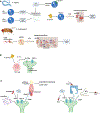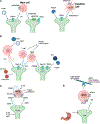Sensory neurons: An integrated component of innate immunity
- PMID: 38599172
- PMCID: PMC11555576
- DOI: 10.1016/j.immuni.2024.03.008
Sensory neurons: An integrated component of innate immunity
Abstract
The sensory nervous system possesses the ability to integrate exogenous threats and endogenous signals to mediate downstream effector functions. Sensory neurons have been shown to activate or suppress host defense and immunity against pathogens, depending on the tissue and disease state. Through this lens, pro- and anti-inflammatory neuroimmune effector functions can be interpreted as evolutionary adaptations by host or pathogen. Here, we discuss recent and impactful examples of neuroimmune circuitry that regulate tissue homeostasis, autoinflammation, and host defense. Apparently paradoxical or conflicting reports in the literature also highlight the complexity of neuroimmune interactions that may depend on tissue- and microbe-specific cues. These findings expand our understanding of the nuanced mechanisms and the greater context of sensory neurons in innate immunity.
Keywords: barrier immunity; host defense; innate immunity; neuroimmune; neurons; sensory.
Copyright © 2024 Elsevier Inc. All rights reserved.
Conflict of interest statement
Declaration of interests I.M.C. serves on the scientific advisory boards of GSK Pharmaceuticals and Nilo Pharmaceuticals. D.H.K. serves on advisory boards for Janssen Pharmaceuticals and Galderma.
Figures





References
-
- Marsal S, Corominas H, de Agustín JJ, Pérez-García C, López-Lasanta M, Borrell H, Reina D, Sanmartí R, Narváez J, Franco-Jarava C, et al. (2021). Non-invasive vagus nerve stimulation for rheumatoid arthritis: a proof-of-concept study. Lancet Rheumatol 3, e262–e269. 10.1016/s2665-9913(20)30425-2. - DOI - PubMed
Publication types
MeSH terms
Grants and funding
LinkOut - more resources
Full Text Sources
Other Literature Sources

